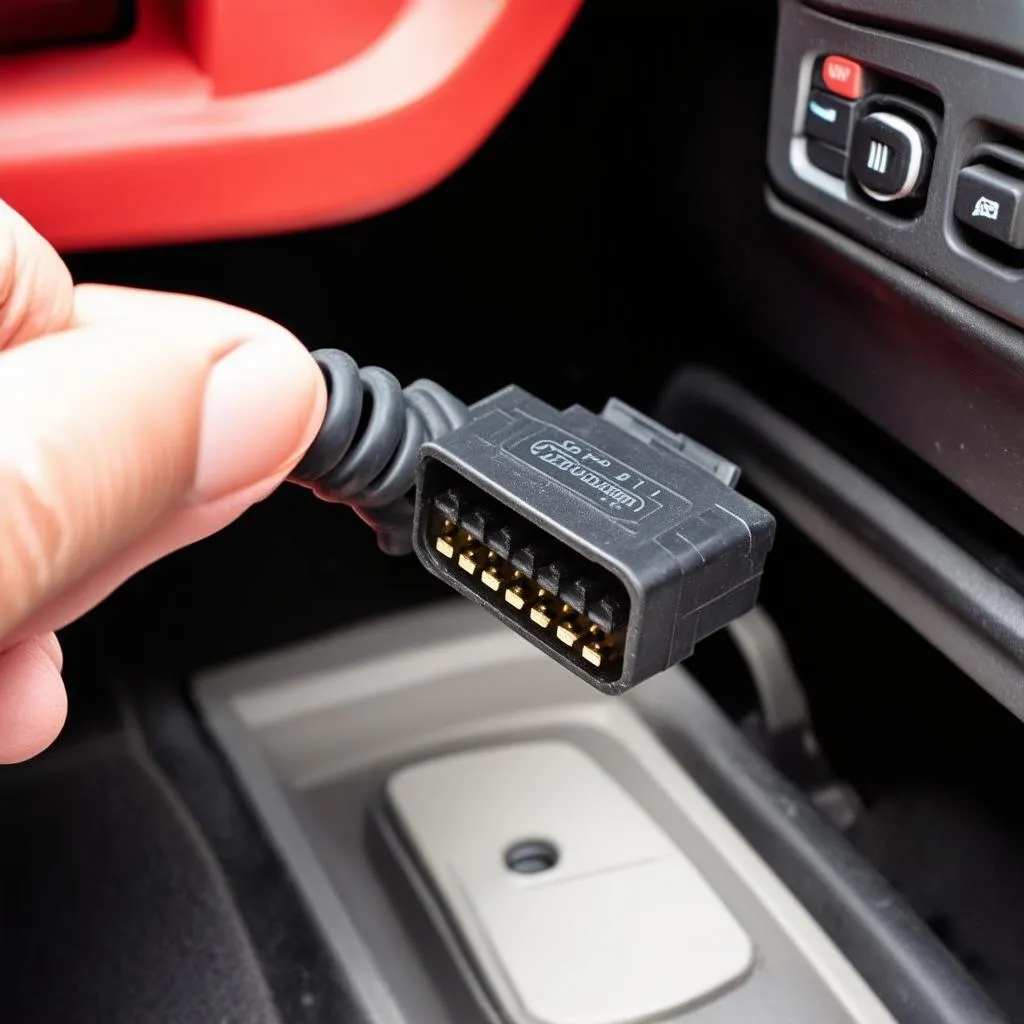“If your Ford could talk, what would it say?” Probably something along the lines of, “Hey, check engine light is on again? You know where to plug in, right?”.
Okay, maybe not quite. But the point is, understanding your car’s onboard diagnostics system, starting with the OBD pinout, can feel like unlocking a secret language. It allows you to directly communicate with your Ford’s computer and get to the bottom of those pesky warning lights or performance hiccups.
What is a Ford Obd Pinout and Why Should I Care?
Imagine this: your Ford Fiesta suddenly starts acting up. You’re miles from the nearest mechanic, and a sense of dread washes over you. This is where your knowledge of the OBD pinout comes in.
In simple terms, the OBD (On-Board Diagnostics) system is your car’s internal health check system. The OBD pinout is basically a map to the connector under your dashboard, telling you which pins control what functions. It’s like having a cheat sheet for talking to your car’s brain!
Why should you care? Because knowing the Ford Obd Pinout allows you to:
- Diagnose problems: Use a scan tool to read and understand those cryptic error codes.
- Reset warning lights: Once you’ve fixed the issue, clear the error codes and move on.
- Monitor performance: Track parameters like engine temperature, fuel efficiency, and more.
Decoding the Ford Obd Pinout
Now, let’s peek under the hood, figuratively speaking. While the exact pin configuration might vary slightly depending on your Ford’s model year, the standard OBD-II connector (found on most cars made after 1996) generally follows this pattern:
| Pin Number | Function |
|---|---|
| 2 | J1850 Bus+ |
| 4 | Chassis Ground |
| 5 | Signal Ground |
| 6 | CAN High (CAN-H) |
| 7 | ISO 9141-2 K Line |
| 10 | J1850 Bus- |
| 14 | CAN Low (CAN-L) |
| 16 | Battery Power |
Don’t let the technical jargon scare you! For most basic diagnostics, you’ll mainly be interested in pins 4, 5, 6, 14, and 16, which are used to establish communication with your scan tool.
Why Knowing Your Pins is Like Understanding Your Car’s Chakra
In many spiritual traditions, including those popular in the East, the flow of energy is paramount. Think of your Ford’s OBD pinout as a map of its own internal energy flow. Just as blocked chakras can lead to imbalances in the body, a poor connection or faulty component within your car’s electrical system, reflected in a specific pin on the OBD connector, can manifest as performance issues.
Understanding this connection can foster a deeper sense of respect and harmony between you and your vehicle.
Common Ford Obd Pinout Questions Answered
Q: I have a pre-1996 Ford. Does it have an OBD system?
A: While older models might have some form of onboard diagnostics, they won’t use the standardized OBD-II system with the 16-pin connector.
Q: Can I use any OBD scanner with my Ford?
A: While generic OBD-II scanners can read basic codes, for more in-depth diagnostics and access to Ford-specific systems, you’ll likely need a dedicated Ford scan tool.
Q: My OBD scanner isn’t connecting. What could be wrong?
A: First, double-check that your car’s ignition is turned to the “ON” position (without starting the engine). If that doesn’t work, inspect the OBD connector for any bent or damaged pins, and ensure your scanner is compatible with your Ford model.
 Ford OBD Connector
Ford OBD Connector
Beyond the Pinout: Troubleshooting Common Ford Issues
Having a grasp of the OBD pinout is just the first step. Let’s delve into some common Ford problems and how this knowledge can help you tackle them:
1. Check Engine Light Glowing Like a Christmas Ornament
This is every car owner’s nightmare. But before you panic, connect your OBD-II scanner and read the error code. A common culprit in Fords is the DPFE sensor (Differential Pressure Feedback EGR sensor), often indicated by codes P0401 or P0402. This sensor monitors the flow of exhaust gas recirculated back into the engine, and a faulty one can impact performance and emissions.
2. Transmission Acting Like a Grumpy Teenager
Ford transmissions, especially older models, have a bit of a reputation. Rough shifting or slipping could point to a faulty solenoid, a common issue often accompanied by codes like P0700 or P0750.
 Ford Transmission
Ford Transmission
3. Electrical Gremlins Playing Tricks
Electrical issues can be particularly frustrating. If you’re experiencing flickering lights, malfunctioning power windows, or other electrical gremlins, the culprit might lie within your Ford’s GEM (Generic Electronic Module) or BCM (Body Control Module).
Need Help Navigating the World of Ford Diagnostics?
Dealing with car troubles can be overwhelming, but remember, you don’t have to go it alone. If you’re feeling lost or need expert assistance with your Ford’s diagnostics, don’t hesitate to reach out.
Contact us on WhatsApp at +84767531508. We offer 24/7 support for all your automotive diagnostic needs, from choosing the right scan tool to interpreting those cryptic error codes.
Keep Your Ford Running Smoothly
Just like a well-maintained garden flourishes, a little TLC goes a long way in keeping your Ford running smoothly for years to come. Understanding your car’s OBD system and knowing how to use the pinout is like having a green thumb for car maintenance.
Want to learn more about specific Ford models or delve deeper into diagnostic techniques? Check out our other helpful articles:
Remember, knowledge is power, and when it comes to your Ford, a little knowledge can save you a lot of headaches (and potentially expensive mechanic bills) down the road.